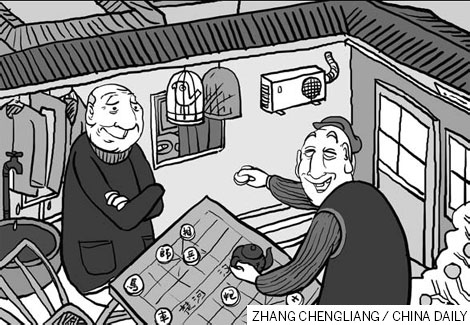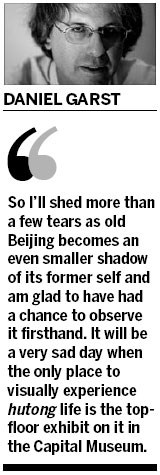Mourning Beijing's lost charms

As recently as 1949, Beijing still looked very much like it did during the Ming and Qing Dynasties. However, in less than a generation, the capital has changed beyond recognition. First, the old walls and gates were torn down. And over the past three decades, most of Beijing's hutong neighborhoods have vanished.
Unlike my diehard preservationist friends, I readily concede that most of the older courtyard houses do not begin to meet even minimal standards for acceptable housing. This point was driven home to me during a recent walking tour of the hutong west of Chaoyangmen.
Two older ladies graciously invited our group into the tiny courtyard rooms that served as their homes. Thanks to electric heaters installed by the local government to replace older polluting coal-burning stoves, their rooms were toasty warm; however, only one of them had running water and neither had a private bathroom.
When I lived in Dongzhimen, the teenage daughter of my neighbors said she liked living in the newer apartment block over the courtyard houses that had covered the east side of Dongzhimen beixiaojie before 2006. I could now understand why she felt that way-while their old housing wasn't that terrible, the new apartment had more modern conveniences and an extra bedroom.

That said, there is much to regret about the ongoing destruction of Beijing's hutong neighborhoods. The city is losing much more than a tourist attraction and playground for affluent laowai and hipster Chinese.
In fact, while living in Dongzhimen, I did many walks through the hutong that still stand west of Dongzhimen beixiaojie (north and south of Dongzhimen's "Ghost Street") I rarely saw foreign tourists and residents of Beijing or hipster Chinese during these strolls.
What I did see were lots of ordinary people going about their daily chores - hanging laundry, cooking snacks and the like. Others would be sitting, chatting and drinking tea or beer with their friends or playing Chinese chess. And lots of small children were playing with their scruffy toys.
It is true that the Nanluoguxiang is now home to numerous hip restaurants and bars and small, chic stores, while the Houhai and Drum and Bell Tower area have become two of Beijing's hottest nightspots. And a similar transformation is occurring at the Wudaoying hutong west of the Lama Temple.
But even around the Nanluoguxiang and Bell and Drum Tower and Houhai, one doesn't have to walk very far to get away from the trendy bars, restaurants, and shops, along with the remodeled courtyard houses snapped up by rich people.
Last fall, for example, I spent an afternoon strolling about and photographing the hutong running off the Nanluoguxiang. I saw there was what I saw during my strolls around Dongzhimen's hutong. The same holds for other walks I have done about the back hutong behind Houhai and the Drum and Bell Tower.
And while hutong dwellers lack material wealth, their neighborhoods provide them with rich sense of community that most other residents of the capital lack. This is well documented in Michael Meyer's book, The Last Days of Old Beijing, based on his participant observer study of the Dashila neighborhood where he lived for more than a year.
Of course, this community can be somewhat preserved in the absence of hutong, provided the residents are not relocated. I could sense while living in Dongzhimen, whose siheyuan residents remained in the neighborhood after their older housing had been torn down.
However, even if the old sense of community remains, destroying the courtyard houses will deprive Beijing of a unique historical architectural heritage.
All other great world cities boast flashy, avant-garde structures like the CCTV Tower and the Bird's Nest. Courtyard houses and hutong set Beijing apart architecturally from other major world cities. And would anyone really prefer a stroll through the cookie-cutter apartment blocks east of the Dongzhimen beixiaojie over the hutong across the street?
Finally, it is not the case that historically Beijing's hutong were the exclusive preserve of the wealthy and powerful.
The Dashila hutong have always been a residential area for ordinary people, as well as home to theaters, shops and famous bookstores. And the Yandai hutong near the Bell and Drum Towers, with its numerous shops and restaurants, were known as north Beijing's Dashila.
Now that this area has again become an entertainment district, one can say that history has come full circle.
So I'll shed more than a few tears as old Beijing becomes an even smaller shadow of its former self and am glad to have had a chance to observe it firstshand. It will be a very sad day when the only place to visually experience hutong life is the top-floor exhibit on it in the Capital Museum.
 0
0 








Go to Forum >>0 Comments